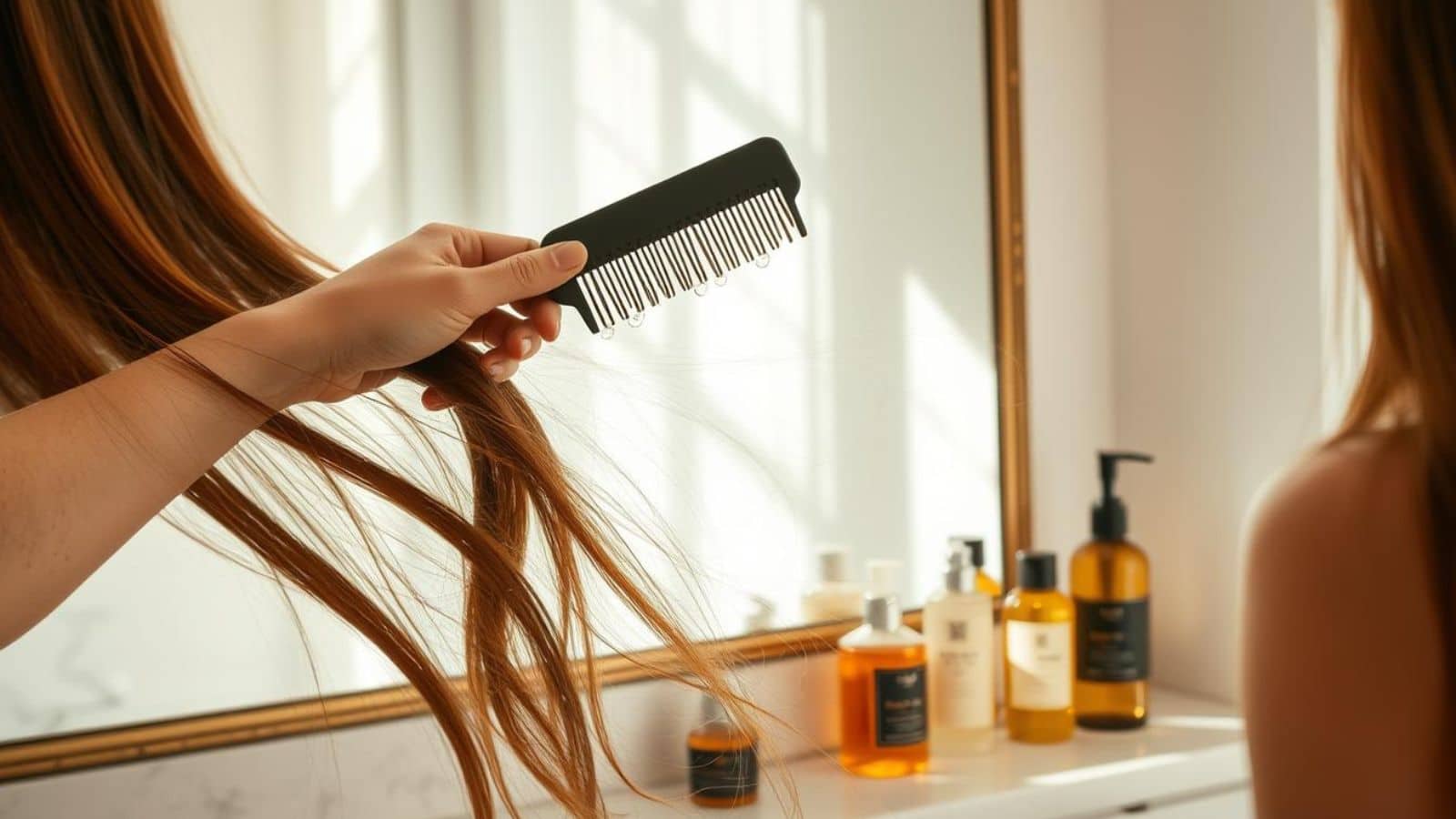 December 5, 2024 | Hair Tips
December 5, 2024 | Hair TipsMany strive for soft and silky smooth hair, but it can seem daunting, especially with frizzy hair, dry hair, or damaged hair. The right hair care routine and products can transform your hair into the smooth, shiny dream you’ve always wanted. Whether your hair is straight, wavy, curly, or coily, there are steps to enhance its health and appearance.

Choosing the right shampoo and conditioner is crucial to make hair soft and smooth. Fine hair benefits from volumizing formulas that don’t weigh it down. Thick or coarse hair needs moisturizing products to soften and smooth strands. A careful grooming routine is also key, including gentle detangling, scalp massage, and heat protection before styling.
Adding hair masks, anti-frizz products, and repair treatments to your routine can significantly improve hair smoothness and health. These products nourish and strengthen your hair, leaving your hair feeling luxurious. With patience and the right approach, you can achieve the smooth, healthy hair you’ve always desired.
Key Takeaways
- Choose the right shampoo and conditioner for your hair type to minimize frizz and improve smoothness.
- Establish a careful grooming routine that includes detangling, scalp massage, and heat protection.
- Incorporate hair masks, anti-frizz products, and repair treatments into your hair care regimen.
- Be cautious with heat styling and avoid harmful chemicals in hair products.
- Regular trims can help maintain smooth, healthy hair by preventing split ends and damage.
Choose the Right Shampoo and Conditioner
Choosing the right shampoo and conditioner is crucial for silky smooth hair. With so many options, it’s vital to consider your hair type and specific needs. This ensures you get the best results.

Different hair types require unique shampoo and conditioner formulas. Fine hair needs volumizing products that won’t weigh it down. Thick or curly hair, on the other hand, requires extra moisture and smoothing agents. Straight hair benefits from smoothing shampoos, while wavy hair does well with balancing formulas.
Damaged or color-treated hair needs strengthening and fortifying products. These help improve its condition and maintain health.
Shampoo for Your Hair Type
When picking a shampoo, think about your hair type and scalp condition. Here are some guidelines for when you wash your hair:
- Fine Hair: Opt for volumizing shampoos that enhance your hair without making it heavy.
- Thick Hair: Hydrating or moisturizing shampoos add moisture, shine, and smoothness to dry thick hair.
- Straight Hair: Choose smoothing or straight hair shampoos rich in moisturizers and smoothing agents for a sleek look.
- Wavy Hair: Balancing shampoos are ideal. They’re not too moisturizing but keep your hair from drying out.
- Curly Hair: Curly hair benefits from very moisturizing shampoos that reduce frizz without weighing down curls.
- Damaged/Colored/Brittle Hair: Strengthening or fortifying shampoos are best for damaged, over-processed, highlighted, weakened, or brittle hair. They contain extra protein to improve hair condition.
Conditioner for Your Hair Type
Choosing the right conditioner is as important as picking the right shampoo. Apply conditioner evenly to the ends of your hair, avoiding the scalp. Here are some tips based on your hair type:
| Hair Type | Conditioner Recommendation |
|---|---|
| Fine or Oily Hair | Use a light or balancing conditioner to avoid weighing down hair |
| Thick, Coarse, or Curly Hair | Opt for a smoothing or moisturizing conditioner and occasional deep conditioning treatments |
| Dry or Damaged Hair | Look for conditioners with nourishing ingredients like oils, butters, and proteins to help repair and protect the hair shaft |
| Color-Treated Hair | Choose color-safe conditioners that help maintain vibrancy and prevent fading |
By choosing shampoos and conditioners tailored to your hair type and needs, you can control frizz, prevent split ends, and maintain your hair’s natural oils. This leads to smoother, healthier-looking locks.
Establish a Careful Grooming Routine
After washing and moisturizing your hair, it’s vital to add more steps to your routine. This ensures your hair stays silky and healthy. A detailed approach can significantly improve the look and feel of your hair.

Detangle Your Hair
Detangling is a key part of hair care. It reduces breakage and removes knots, leading to smoother styling. Use a wide-tooth comb or detangling brush, starting from the ends and working up. Be patient and gentle to avoid damage.
Massage Your Scalp
Scalp massages are beneficial between washes. They stimulate follicles, remove dead skin, and promote growth. Use your fingertips for gentle, circular motions. This not only relaxes but also boosts blood flow and natural oil production, enhancing hair shine.
| Scalp Massage Benefits | How Often |
|---|---|
| Stimulates hair follicles | 2-3 times per week |
| Removes dead skin cells | During each wash |
| Promotes hair growth | Daily, if possible |
Use a Heat Protectant
Styling tools like flat irons and blow dryers require heat protectants. These products shield your hair from heat damage. Apply evenly before styling and use lower temperatures to minimize damage.
Also, consider satin pillowcases or overnight bonnets. They reduce frizz and keep hair smooth while you sleep. Unlike cotton, these materials cause less friction, preserving your hair’s smoothness and giving your hair soft and silky texture.
Silky Smooth Hair Care Tips
To get smooth hair, combine proper hair care techniques with nourishing products. Rinsing your hair with cold water after shampooing and conditioning is essential. Cold water seals the hair cuticles, locking in moisture and reducing frizz for a smoother look and feel.
Regular trims are crucial for maintaining healthy, smooth hair. For longer hair, aim to get your ends snipped every 3-4 months. Shorter hair requires a trim every 6-8 weeks. Trimming eliminates split ends and damaged tips, promoting a softer and silkier texture overall.
When selecting hair care products, avoid harmful chemicals that strip your hair of its natural oils and protective layer. Steer clear of products containing parabens, silicones, sulfates, and phthalates. These ingredients can lead to brittle, dry hair over time. Instead, choose nourishing formulas that focus on smoothing, moisturizing, and strengthening your hair’s natural defenses.
| Ingredient to Avoid | Potential Harm | Alternative |
|---|---|---|
| Parabens | Can disrupt hormones and cause skin irritation | Natural preservatives like grapefruit seed extract |
| Silicones | Can build up on hair, making it heavy and greasy | Natural oils like argan or jojoba oil |
| Sulfates | Can strip hair of natural oils, causing dryness and breakage | Gentle, sulfate-free cleansers |
| Phthalates | Can cause hormonal disruption and developmental issues | Natural fragrances or essential oils |
“The key to achieving smooth, healthy hair is to nourish it from the inside out. By using high-quality products and implementing gentle hair care practices, you can transform your locks and enjoy the silky, smooth hair you’ve always wanted.” – Carlos Alvarez, Global Hair Stylist
By following these smooth hair care tips and being mindful of the products you use, you’ll be well on your way to achieving the lustrous, frizz-free hair of your dreams. Remember, consistency is key – stick to a regular hair care routine, and you’ll soon see the amazing results for yourself!
Hair Products To Get Silky Smooth Hair
Adding specific hair products to your weekly routine can lead to smooth, silky hair. You can choose from deep moisture hair masks, anti-frizz serums, and hair repair treatments. Let’s explore some top picks for smooth, frizz-free hair.
Hair Masks
Hair masks offer deep moisture and nourishment. They combat frizz, making your hair smooth and easy to manage. The Kerasilk Keratin Treatment is a popular choice.
Anti-Frizz Products
Anti-frizz products, like smoothing style creams and lightweight hair oils, tame frizz and nourish your hair. The Oribe Supershine Moisturizing Cream is a high-quality choice for those fighting frizz.
For a budget-friendly option, try the Noughty To The Rescue Anti-Frizz Hair Serum. This serum smooths hair and protects against humidity, leaving it sleek and shiny.
Hair Repair Treatments
Hair repair treatments strengthen and restore damaged hair. The Kerasilk Reconstruct Hair Treatment is a favorite. It acts as a bond builder, repairing and strengthening damaged hair.
Conclusion
Getting silky-smooth hair is achievable with the right products, techniques, and a consistent routine. Choose the right shampoo and conditioner, priced from $20.25 to $30.25, to start. This sets the stage for healthy, frizz-free locks. A detailed grooming routine, including detangling, scalp massages, and heat protectants, boosts hair softness and shine.
Adding smoothing hair products like masks, anti-frizz creams, and repair treatments to your care can greatly improve your hair’s look. Using top-notch products, such as those from Goldwell and Oribe, consistently is key. Also, regular hair cut trims every 6-8 weeks and weekly deep conditioning treatments are crucial for hair health.
For better hair health, eat a diet full of proteins, vitamins, and minerals. Avoid shampoos with sulfates to prevent dryness. Be cautious of tight hairstyles and harsh styling methods that can harm your hair. Protect it from UV rays and pollution too. By following these guidelines and getting professional advice from a salon like Trademark Salon in Houston, Texas, you can enjoy silky, shiny hair every day.
Frequently Asked Questions
What are the indicators of smooth, silky hair?
Smooth, silky hair feels soft and sleek. It’s easy to run your fingers through without tangles. It has a healthy shine and appears well-moisturized, with minimal frizz or flyaways.
How do I choose the right shampoo and conditioner for my hair type?
For thick or curly hair, choose a smoothing shampoo that provides extra conditioning and moisture. Fine hair benefits from a volumizing shampoo that gently cleanses without weighing it down. When conditioning, apply the product evenly to the ends of your hair, avoiding the scalp. Use a light or balancing conditioner for fine or oily hair, and a smoothing or moisturizing conditioner for thick, coarse, or curly hair.
What additional steps can I incorporate into my grooming routine for smoother hair?
After cleansing and moisturizing your hair, gently detangle it to minimize breakage and eliminate knots. Massage your scalp between washes to stimulate hair follicles, remove dead skin cells, and promote healthy hair growth. When using heat styling tools, apply a heat protectant spray to shield your hair from damage, and set your tools to a lower temperature. Consider using a satin pillowcase or overnight bonnet to maintain smoothness and reduce frizz while you sleep.
What are some tips for achieving smooth hair?
Rinse your hair with cold water to close hair cuticles and seal in moisture, which helps decrease frizz. Trim your hair regularly to maintain smooth, healthy ends. When shopping for hair care products, avoid harmful chemicals like parabens, silicones, sulfates, and phthalates, as they can strip your hair of its natural oils and lead to brittle, dry hair. Instead, opt for products that focus on smoothing, moisturizing, and protecting your hair’s natural protective layer.
What hair products can help me achieve and maintain smooth hair?
Incorporate hair masks, like a deep moisture mask, into your weekly routine for maximum moisture and frizz protection. Use anti-frizz products, such as smoothing style creams or lightweight hair oils, for added nourishment and protection against humidity. For damaged hair, consider using hair repair treatments like a triple bond complex or bond builder to strengthen your hair and make it less susceptible to damage. A healthy hair perfector can restore your hair’s outermost protective layer, resulting in a smooth look and feel.
How often should I trim my hair to maintain smooth, healthy ends?
To maintain smooth, healthy ends, trim your hair every 3-4 months for longer hair and every 6-8 weeks for shorter hair. Regular trims help prevent split ends and keep your hair looking sleek and well-maintained.
